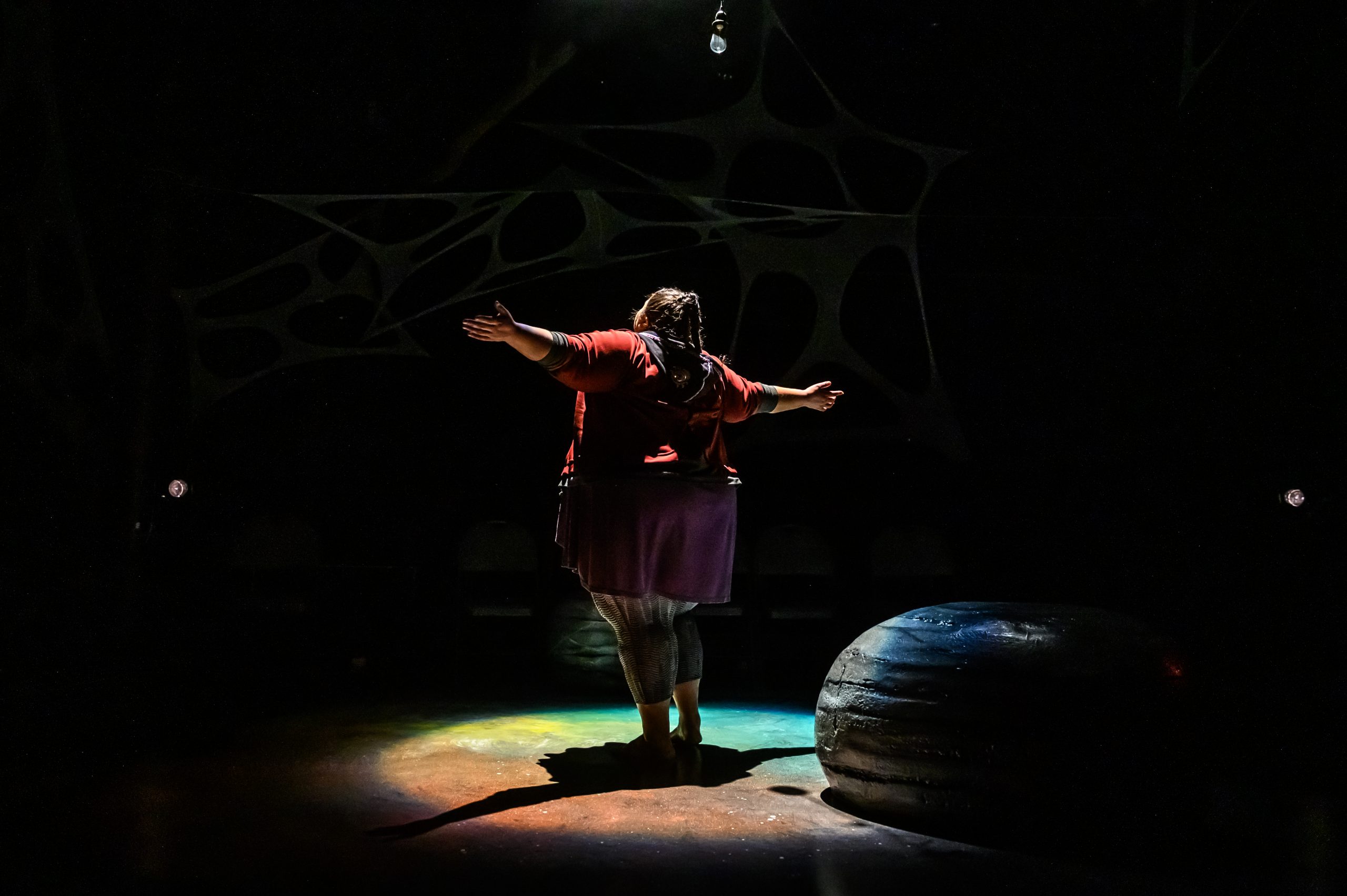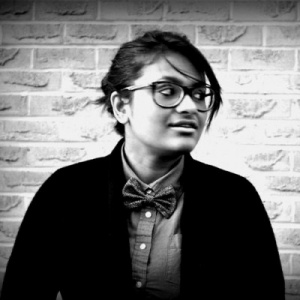Decolonizing Theatre Practice as a Playwright and Performer: A Conversation with Yolanda Bonnell
Anishinaabe South Asian playwright Yolanda Bonnell’s requested to have her play bug (Theatre Passe Muraille Theatre) reviewed only by writers who were Indigenous, Black, or people of colour (IBPOC). Ever since her request aired on CBC Radio’s q, it has started a conversation about the uneasy relationship between IBPOC theatre artists and white critics. The conversation has also ignited a flurry of online racism and vitriol aimed at Indigenous playwrights Bonnell and Kim Senklip Harvey (Bonnell’s mentor). I contextualized this online furor in my op-ed recently published in THIS Magazine. This interview, about what Yvette Nolan in her CBC article calls the “tempest around Yolanda Bonnell’s request,” was conducted over telephone on February 18, 2020, halfway through the run of bug.
Let’s talk about bug. How has the audience been reacting? I have been reading some very positive reviews on social media.
It’s going really well…The great thing about the Q&A afterwards is that we actually get a chance to hear from the audience. And that wasn’t the initial reasoning. I mean, most of it was [about having] this creative space where folks could have a community discussion about what they just saw, or if they are feeling a certain sort of way, we can discuss that in a group setting. It was also a way for people to give feedback, which is great. So, because of that [Q&A], we had so many Indigenous people–women and men, trans and non-binary folks–who talk about how much they relate to the story, which has been really beautiful. I am overwhelmed with the responses–I mean, this is why I do it, right? This is why my whole [intended] outcome was that particularly Indigenous people would look at it, and say, “Yes! This is what we go through,” or “This is how we feel.” And to have validation, I suppose, from Indigenous audience members–there’s nothing like that, and that’s probably been the most extraordinary and beautiful thing about this whole process.

Yolanda Bonnell in bug. Photo by Dahlia Katz.
Yes, I guess the audience you are writing and performing for is basically Indigenous folks. It’s not the reviewers who have been fighting about whether they are allowed to review your play or not.
The thing about misunderstanding this whole thing [about my request to the media to have IBPOC reviewers] is that I am welcoming everyone. Everyone is welcome to come. In fact, it’s important that [racialized and non-racialized] others see this show as well, to understand the ongoing effects of colonialism and intergenerational trauma. I think people sort of have this misunderstanding about what that actually means. But trauma gets passed on through our bloodlines now because it’s been years of violence. So, it is important that everybody comes to the show. But I think for reviews, I didn’t want to put that lens on it. I have had non-Indigenous audience members as well who have found their connection to the play too, so that’s also been really great. I wrote [the play] in such a metaphorical way that I wanted people to have access points to it that they choose to feel connected to the material.
Right. And it was very clear in your official statement that nobody was banned or being kept away from this play. Everyone was welcome. The fact that you had to write the Vice essay to clarify what you meant speaks volumes; that you were literally forced to put your back against the wall and be made to reiterate the same message. I recently read a nice breakdown of your play on Twitter by a South Asian woman, Diwali Luharia, about what to expect from the play and so on, which highlighted that non Indigenous racialized folks are reacting positively to your work.

Yolanda Bonnell in bug. Photo by Dahlia Katz.
Yeah. And I think there is a common experience amongst racialized groups and other marginalized communities. There is a way that we walk through life, and the way that outsiders see us. And so, I think that was part of the reason why we wanted to ensure that those [Indigenous, Black, people of colour] voices were the ones that were being amplified by the media. As people of colour or marginalized folks, we have an understanding of the world that I don’t think other people do.
For sure. We have to navigate the world differently because of the way we have been racialized to begin with.
Exactly.
In your official statement, you said that your desire to invite IBPOC reviewers was an aspect of your cultural work which was aligned with your current reviewing practices; it was one way to decolonize theatre. Can you speak to other ways that you are decolonizing the theatre space?
So, myself and Cole Alvis, we run the manidoons collective. It’s important to us that as we navigate through this institution or industry of theatre, we make it safe for all artists—particularly, artists of colour. The current practice of theatre is not sustainable and not healthy. We wanted to look back and see, what is Indigenous theatre? And if Indigenous theatre includes decolonizing, then in what other ways can we do this? And that includes things like shorter rehearsal days–potentially shorter rehearsal weeks–and beginning each day with a talking circle. This idea in the professional industry world of leaving your shit at the door is just not real. It’s not an actual thing you can do. And so, rather than that, let’s talk about where you are at today. So that we are in space with each other… we can respect each other, and where our bodies are at.

Yolanda Bonnell in bug. Photo by Dahlia Katz.
Working with the seven [Ojibwe] values or the seven teachings—that was another way to bring Anishinaabe teaching into the room and understanding where those [teachings] fall. A lot of these practices were brought up by Lindsay Lachance, the Artistic Associate of the NAC Indigenous Theatre. She is an incredible Indigenous artist and dramaturge. As well as Kim Senklip Harvey, who is a playwright. It was through witnessing other matriarchs doing this work and bringing a lot of these ideas forward.
So, we have been doing this for a long time. I think it’s just no one’s been interested in it, or has been willing to back it up. And now, we are in a time where, I think, artists and directors are like, “Yeah, this is the right direction. So let’s support artists who are doing this.”
And there are other ways we will be learning how to decolonize theatre. There is a program note which says that we don’t have all the answers. Decolonizing is a messy [process]. It’s breaking down structures, and when you tear down structures, you are left with a mess. So then, you have to figure out what works, and how do we put this together in a way that stays sustainable and is healthy for everyone involved.

Yolanda Bonnell in bug. Photo by Dahlia Katz.
So, this kind of work that you have experienced before, is this when you worked on Kamloopa [with Kim Senklip Harvey], or in other ways as well?
Kamloopa was the big one. Lindsay was the dramaturge on that piece, and Kim was the playwright. A lot of the protocols [for bug] were inspired by what we did there. So, going out and greeting and welcoming witnesses into the lodge, or the theatre, was important to understand artistic ceremony… a lot of the talking circles were brought up there, the shorter days we were doing. It’s been a combination of different ways of being in space… Every show I have ever been in, it’s given me some kind of knowledge or some kind of teaching.
How do you think this experience of ongoing racism online as a result of your request, and the way your words have been misunderstood – how has this experience affected you, or changed you?
That’s a really good question, and I am still figuring it out. Because it’s still going on… it hurt. I am human [laughs]. Especially last week was really difficult. Personally, I had a lot of trouble sleeping. I was crying a lot randomly. But I felt that I needed to hold this together because I still have a show to do… and I think it happens a lot in our community, where we women of colour feel like we have to hold it together. I will be honest, I struggled a lot last week. I am doing better now.
I guess I just didn’t realize the power of words or opinions of a person of colour can be so threatening to white settlers [laughs]. It totally caught me off guard. Nobody was expecting this. I think more than anything, it made me evaluate where my readership status is, or how my voice is being heard. But I haven’t really come to terms with wrapping my head around it. You know what? Ask me when the show is done! [laughs]

Yolanda Bonnell in bug. Photo by Gilad Cohen.
[Laughing] Let’s not revisit it at all actually.
Towards the end of your essay in Vice, you make a connection to what’s happening on Wet’suwet’en territory. And you said that the discourse of the response to your reviewing request cannot be isolated from this bigger discourse of Wet’suwet’en land defenders. To quote you: “White supremacy is alive and well in this country, we have seen it clearly with what’s happening on Wet’suwet’en territory, we see it in the hate that we receive online and in person. But that doesn’t mean that we can’t fight back. Our communities are strong and we have more power than colonial institutions would lead us to believe.” Can you speak more to that power?
Institutions want to make us feel like they are doing us a favour by inviting us into their space… I mean, part of that is true. They do have that power. These institutions predominantly run by white folks do have the power to amplify voices; that is them using their privilege. But I think that we have way more power to challenge these systems and institutions, and say that, “This is how we need to work in your space. If you want to work with us, you need to meet us at this point.” So that it becomes a conversation or an agreement or treaty; that there is a way of working that is not one holding power over the other… I think it’s time to use our voices, and institutions need to be backing that. I think we just need to really believe, and use the power and strength that we do have in our corners to make sure our work is being respected.









Comments